Legion Class Preview Series: Warlock
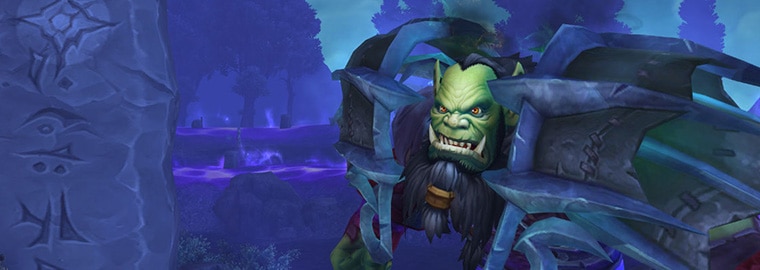

Welcome to our World of Warcraft: Legion class preview series. In this entry, we’re exploring the Warlock—to find out what’s in store for a different class, check out the overview.
We continue our early look at class and specialization design with the Warlock. In these blogs, we’ll be exploring class identity, discussing Legion’s new designs, and presenting core combat abilities for each specialization—laying out the foundation upon which talents and Artifacts will build further. With that in mind, let’s delve into what it means to be a Warlock in World of Warcraft.
Warlocks are the most volatile and insatiable of spellcasters. Though they often pledge themselves to the service of noble causes and are not innately evil, their desire to understand darker magics and exercise unwavering command over demonic forces breeds mistrust among even their closest allies.
Warlocks peer into the Void without hesitation, leveraging the chaos they glimpse within to devastating ends in battle—their greatest abilities are fueled by the souls they’ve harvested from their victims. They exploit powerful Shadow magic to manipulate and degrade the minds and bodies of their enemies. They employ Fire magic, dropping hellish rain from the sky, to immolate the opposition. They summon and command indomitable demons from the Twisting Nether to do their bidding, or even to be sacrificed as the Warlock sees fit, empowering and protecting the dark caster from harm.
The foundation of the Warlock class has been long and well established in Warcraft lore. However, while Affliction and Destruction Warlocks have maintained consistent, distinguished fantasies, the core identity of the Demonology Warlock has strayed too far from its roots in recent years. A primary goal for Warlocks in Legion is to accentuate the existing motifs for Affliction and Destruction, while returning Demonology back to its roots of summoning, utilizing, and empowering demons.
Warlock resources have also become too cumbersome, causing confusion that outweighed their depth. To this end, we’re going to once again standardize Warlocks on their most class-defining resources: Mana and Soul Shards. Finally, demons have always served various utility purposes, but most of them are very niche, while the same one or two demons see the vast majority of limelight. We want to re-incentivize demon variety, strengthening the various utilities that each demon supplies, and causing some demons to be favored based on the Warlock’s spec.
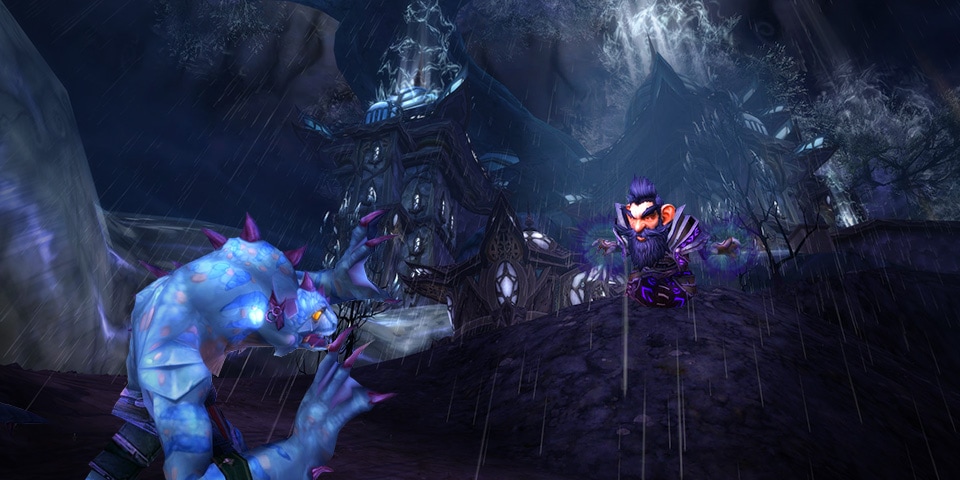

Affliction
Affliction warlocks are masters of shadow-touched powers, but unlike shadow priests—deadliest when pushed to the brink of insanity—these warlocks delight in using fel forces to cause intense pain and suffering in others. They revel in corrupting minds and agonizing souls, leaving enemies in a state of torment that would see them undone in due time. Even the most battle-hardened warriors can be deceived, landing blow after blow against the warlock, only to succumb to their suffering as their very vitality is siphoned away by the dark spellcaster.
“These warlocks delight in using fel forces to cause intense pain and suffering in others”
Gameplay
Affliction Warlocks’ gameplay has always aligned well with their character, but in terms of abilities, we want to avoid the feeling that DoTs are amplifiers for your channeled single-target damage. Applying spells that do damage over time is very core to Affliction, so we want to reinforce these spells as the primary source of damage, with other “filler” spells feeling more secondary. We’re adjusting the Affliction rotation so that DoTs are stronger, and your focus is more on figuring out how best to juggle those DoTs to maximize damage output.
Mechanically, we’re altering how Soul Shards are generated and spent, in part to better deliver on the more DoT-driven damage. Soul Shards are now generated by each Agony you have up on your targets, instead of only by your most recent Corruption cast, to favor placing DoTs on several targets rapidly (multi-dotting). You’ll then spend Soul Shards on an extremely strong DoT in Unstable Affliction, reinforcing the focus on DoTs.
Finally, in keeping with the Affliction theme, Drain Life serves as the main filler spell, instead of Malefic Grasp or Drain Soul. This better matches the Affliction identity because its damage stays secondary to the DoTs, which should be the primary focus of damage, instead of dwarfing them. It also adds significant self-healing, further playing to the Affliction motif.
To give you an idea of the Affliction Warlock in action, here’s a basic look at their core combat abilities:
- Corruption
- 3% Mana, 40 yd range, Instant
- Corrupts the target, causing moderate Shadow damage over 14 sec.
- Agony
- 3% Mana, 40 yd range, Instant
- Inflicts increasing agony on the target, causing up to a huge amount of Shadow damage over 18 sec. Damage starts low and increases over the duration. Refreshing Agony maintains its current damage level.
- When Agony deals damage, you have a chance to regain a Soul Shard.
- Unstable Affliction
- 1 Soul Shard, 40 yd range, 1.5 sec cast
- An especially insidious affliction that deals strong Shadow damage over 8 sec.
- If the target dies, the Soul Shard will be refunded.
- If Unstable Affliction is dispelled, the dispeller suffers strong Shadow damage and is silenced for 4 sec.
- Drain Life
- 3% Mana, plus 4,800 per sec, 40 yd range, Channeled
- Drains life from the target, causing moderate shadow damage and restoring 18% of the caster’s health over 6 sec.
- Drain Life’s damage is increased by 50% for each of your Corruption, Agony, and Unstable Affliction effects on the target.
- Mastery: Potent Afflictions
- Increases the damage of Agony, Corruption, and Unstable Affliction by 62.5% (with Mastery from typical gear).
Additionally, to provide a glimpse at how some talents may build upon this, here’s one example of an Affliction-specific talent:
- Contagion
- Passive
- After you cast Unstable Affliction, you can cast a second one for free, within 3 seconds.
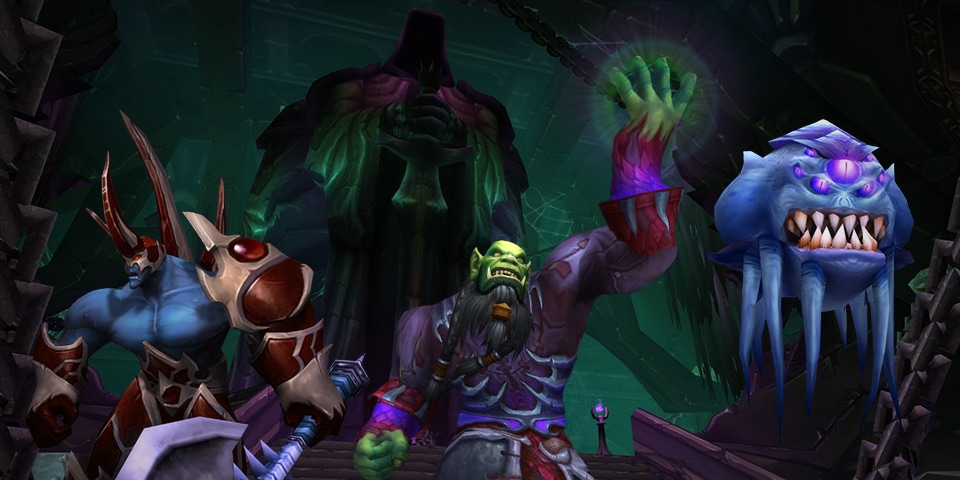

Demonology
By their very nature, demons are leeches on the living universe—but the demonologist has mastered harnessing the power of these malefic beings on the field of battle. Warlocks harvest the souls of their defeated enemies; those specialized in the ways of demonology use this life essence to tap into the Void, pulling all manner of abomination from the chaos of the Twisting Nether. While such a practice is often considered by outsiders to be wicked and reckless, the demonologist maintains absolute control over the summoned creatures. These malignant entities are fully beholden to—and empowered by—the will of the warlock, until banished to the realm from whence they came.
“The demonologist has mastered harnessing the power of malefic beings on the field of battle”
Gameplay
While all Warlocks maintain the power to summon demons, Demonology is distinguished by the ability to call forth waves of demons to overwhelm the opposition, and also to further empower the demons they summon. Over the years we strayed too far from this design, to the extent that Demonology gameplay was defined more by the Warlock becoming a demon. Legion provides a fitting opportunity for us to realign the spec around its core function of mastering control of demons, not transforming into them.
We also recognize that Demonology had a large array of intertwined mechanics that weren’t intuitive, and they’ve undergone a greater degree of redesign as a result. For those who played Demonology during Warlords of Draenor, the gameplay will feel quite different in Legion. Beta test feedback will be essential in helping us to ensure that the new spec feels strong and enjoyable and that we’ve accomplished our goal of returning Demonology to its foundations.
To give you an idea of the Demonology Warlock in action, here’s a basic look at their core combat abilities:
- Shadow Bolt
- 6% Mana, 40 yd range, 2.5 sec cast
- Sends a shadowy bolt at the enemy, causing minor Shadow damage. Generates 1 Soul Shard.
- Call Dreadstalkers
- 2 Soul Shards, 40 yd range, 2 sec cast, 15 sec cooldown
- Summon 2 ferocious Dreadstalkers to attack the target for 12 sec.
- Hand of Gul’dan
- 1 to 5 Soul Shards, 40 yd range, 1.5 sec cast
- Calls down a demonic meteor full of Wild Imps which burst forth to attack the target for 12 sec.
- Deals up to a strong amount of Shadow damage to all enemies within 8 yds and summons up to 5 Wild Imps, based on Soul Shards consumed.
- Demonic Empowerment
- 6% Mana, 1.5 sec cast, 12 sec recharge, 3 charges
- Empowers up to 3 of your active demons with dark energies, increasing their Haste and health by 50% for 12 sec.
- Prefers stronger demons first.
- Mastery: Master Demonologist
- Demonic Empowerment also increases the damage of your demons by 50% (with Mastery from typical gear).
- Doom
- 2% Mana, 40 yd range, Instant
- Inflicts impending doom upon the target, causing absolutely massive Shadow damage after 20 seconds
- Generates a Soul Shard when it deals damage.
- Demonwrath
- 2.5% Mana per sec, Channeled
- Your demons crackle with demonic energy. Every 1 sec, all enemies within 10 yds of any of your demons take minor Shadow damage.
- Each time Demonwrath deals damage, it has a 15% chance to generate a Soul Shard.
- May be channeled while moving.
Additionally, to provide a glimpse at how some talents may build upon this, here’s one example of a Demonology-specific talent:
- Implosion
- 6% Mana, Instant
- Causes all of your Wild Imps to be violently yanked toward the target, and then explode, dealing moderate Shadow damage to all enemies near them.
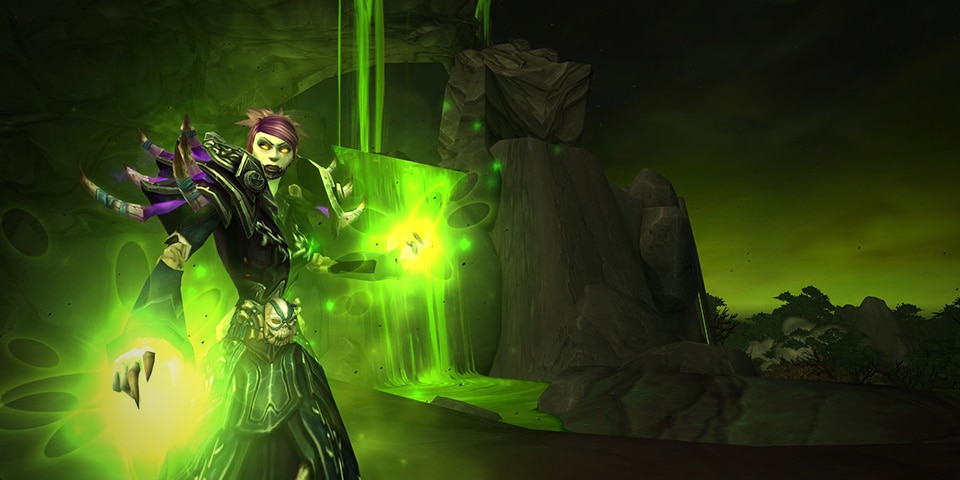

Destruction
Warlocks who command the power of destruction favor incantations of pure chaos and aggression in battle. In this regard, they’d find a stronger kinship with fire mages than warlocks of other disciplines—if not for their propensity to make use of magic deemed detestable by all mage orders. The destruction warlock is well-versed in discharging a dizzying array of shadow, fel, fire, and chaos magics upon opponents that rattle souls and conflagrate bodies. They require little motivation for the havoc they wreak, happy to revel in the destruction they cause—thrilled at any opportunity to watch the world erupt in discord around them.
“Warlocks who command the power of destruction favor incantations of pure chaos and aggression”
Gameplay
Destruction mechanics are in a solid place overall and are already a good match thematically, so we’re taking the opportunity in Legion to provide additional polish on existing gameplay. While resource mechanic functionality isn’t being drastically overhauled, we’ve changed Burning Embers back to Soul Shards. Not only does this return consistency across all Warlock specs, it also reestablishes the Soul Shard as the iconic source of Warlock power.
To give you an idea of the Destruction Warlock in action, here’s a basic look at their core combat abilities:
- Incinerate
- 6% Mana, 40 yd range, 2 sec cast
- Draws fire toward the enemy, dealing moderate Fire damage.
- Immolate
- 6% Mana, 40 yd range, 1.5 sec cast
- Burns the enemy with fire, causing minor Fire damage and an additional strong Fire damage over 15 sec.
- Immolate critical strikes have a 30% chance to generate a Soul Shard.
- Conflagrate
- 2% Mana, 40 yd range, Instant, 8 sec recharge, 2 charges
- Triggers an explosion of fire on the target, dealing moderate Fire damage and generating a Soul Shard.
- Also causes Backdraft, reducing the cast times of Incinerate and Chaos Bolt by 30% for 5 sec.
- Chaos Bolt
- 2 Soul Shards, 40 yd range, 2.5 sec cast
- Unleashes a devastating blast of chaos, causing huge Shadow damage. Chaos Bolt always critically strikes and your critical strike chance increases its damage.
- Havoc
- 8% Mana, 40 yd range, Instant, 20 sec cooldown
- Mark a target with Havoc for 8 sec, causing your single target spells to also strike them. Limit 1.
- Mastery: Chaotic Energies
- Your Destruction spells deal up to 40% (with Mastery from typical gear) additional damage, randomly.
Additionally, to provide a glimpse at how some talents may build upon this, here’s one example of a Destruction-specific talent:
- Channel Demonfire
- 4.8% Mana, Channeled, 12 se cooldown
- Launches 15 bolts of felfire at Immolated enemies within 40 yds, over 3 sec. Each bolt deals moderate Fire damage.
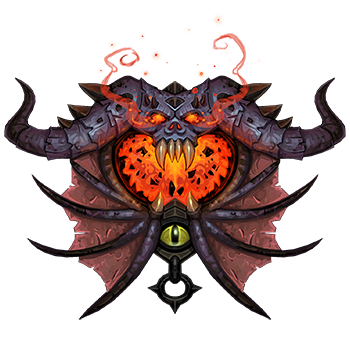

We hope you’ve enjoyed this early preview of our approach to class and specialization design in World of Warcraft: Legion. We’ll continue our review later today with a look at Death Knights and Shaman.
Legion Class Preview Series: Death Knight
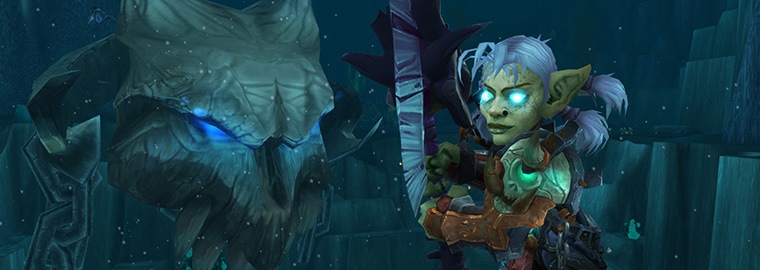

Welcome to our World of Warcraft: Legion class preview series. In this entry, we’re exploring the Death Knight—to find out what’s in store for a different class, check out the overview.
We continue our early look at class and specialization design with the Death Knight. In these blogs, we’ll be exploring class identity, discussing Legion’s new designs, and presenting core combat abilities for each specialization—laying out the foundation upon which talents and Artifacts will build further. With that in mind, let’s delve into what it means to be a Death Knight in World of Warcraft.
The first new class introduced to World of Warcraft after its launch, Death Knights came into the fray with an identity unmistakably tied to the Wrath of the Lich King story. The Death Knights of Acherus, their cold bodies lifted from the grave in the Scarlet Enclave, were commanded by the Lich King and Highlord Darion Mograine to slaughter every villager in Tyr’s Hand, New Avalon, and Havenshire, and to sack Light’s Hope Chapel, decimating both the Scarlet Crusade and the Argent Dawn.
Ultimately, as a result of such uncompromising ambition, the Lich King was betrayed by Highlord Mograine in an act that freed the Death Knights from their servitude. Under Mograine’s leadership they formed the Knights of the Ebon Blade and began joining the ranks of the Horde and Alliance forces bound for Icecrown Citadel to end the reign of Arthas, the Lich King. Though now free from the Lich King’s grasp, these once virtuous champions remain knights of darkness, wielding runeblades of death and destruction and mercilessly stealing the very life essence of their enemies.
We always want to reflect the Death Knight origin story and identity in how they play. The biggest area where we see room for improvement is in their resource system. Runes are a very iconic resource, but their functionality has always been convoluted. In Legion, we’re making Runes more straightforward by removing their division into separate Blood, Frost, and Unholy types. Death Knights now have six unified Runes to spend, with a maximum of three recharging at any one time.
With this change, it’s also important that we preserve the existing gameplay familiarity of Death Knights by making mostly minor changes to core ability functionality and cost—we don’t want the Rune change to create a situation where the best Frost rotation is just Obliterate, Obliterate, Obliterate. Finally, we’re reducing ability overlap between specializations, giving each a single disease with a unique trait and creating a talent tree that’s largely populated with spec-specific talents to better distinguish them.
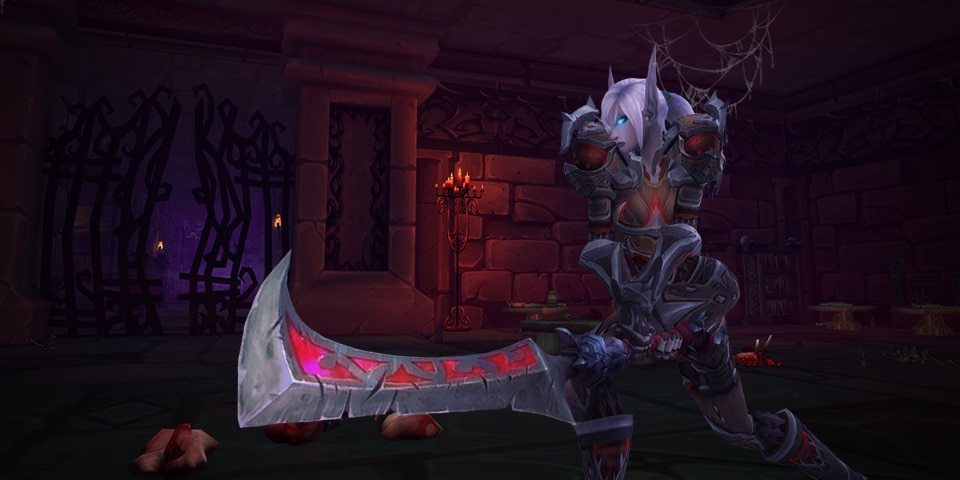

Blood
In undeath, some death knights find a special affinity for the blood and bone of the living. They carve into their enemies, sustaining themselves with deadly sanguine strikes, while using the bloody, shattered remains of the dead to fortify their own defenses. These crimson-soaked knights bend the very rules of mortality to control the frontlines of the battlefield.
“These crimson-soaked knights bend the very rules of mortality to control the frontlines of the battlefield”
Gameplay
The core abilities for Blood should be familiar, though we’ve touched them up to bring added clarity to the specialization. Each core ability now better leverages that sinister command of blood and bone to fuel your survivability. In particular, we’ve changed Death Strike to cost Runic Power instead of Runes. This results in a more clear choice of resource expenditure; you can’t lock yourself out of being able to heal if you spend a Rune at the wrong time, and also gives Runic Power generation a bigger impact.
Instead of Rune Tap, we’re positioning Bone Shield to be the primary complement to Death Strike for active defenses to better tie into the fantasy and provide more flexibility. Marrowrend is a new attack which allows you to rotationally generate Bone Shields. To provide gameplay contention between Runes of a single type, Blood Strike now generates additional Runic Power on top of the standard amount gained for spending a Rune.
Here’s a basic look at the core defensive and offensive combat abilities for Blood Death Knights:
- Blood Strike
- 1 Rune, Melee Range, Instant
- Instantly strike the enemy, causing moderate Physical damage and infecting the victim with Blood Plague.
- Generates 10 bonus Runic Power.
- Blood Plague
- A disease that deals minor Shadow damage and heals the caster for 1% of their maximum health every 3 sec for 30 sec.
- Marrowrend
- 2 Runes, Melee Range, Instant
- Smash the target, dealing strong Physical damage and generating 3 charges of Bone Shield.
- Bone Shield
- Surrounds you with a barrier of whirling bones that reduces all damage you take by 25%. Each damaging attack consumes a charge. Lasts for 30 sec or until all charges are consumed.
- Death Strike
- 40 Runic Power, Melee Range, Instant
- Focuses dark power into a strike that deals strong Physical damage and heals you for 50% of all damage taken in the last 6 sec (minimum 7% of maximum health).
- If you are below 35% health when this is cast, all Runic Power is consumed, increasing the potency of the healing effect.
- Mastery: Blood Shield
- Each time you heal yourself with Death Strike, you gain 40% (with Mastery from typical gear) of the base amount healed as a Physical damage absorption shield.
- Also increases your Attack Power by 20% (with Mastery from typical gear).
- Death and Decay
- 1 Rune, 30 yd range, Instant, 30 sec cooldown
- Corrupts the ground targeted by the Death Knight, causing moderate Shadow damage over 10 sec to targets within the area. While you remain within the targeted area, your Blood Strike will hit all nearby enemies.
- Crimson Scourge
- Passive
- Your successful autoattacks on targets infected with your Blood Plague have a 25% chance to reset the cooldown on Death and Decay.
To give you an idea of how some talents may build upon this core rotation, here’s an example of a Blood-specific talent:
- Bonestorm
- 15 Runic Power per sec, Instant, 1 min cooldown
- A whirl of bone and gore batters nearby enemies 3 times per second to deal minor Shadow damage, healing you for 1% of your maximum health per strike.
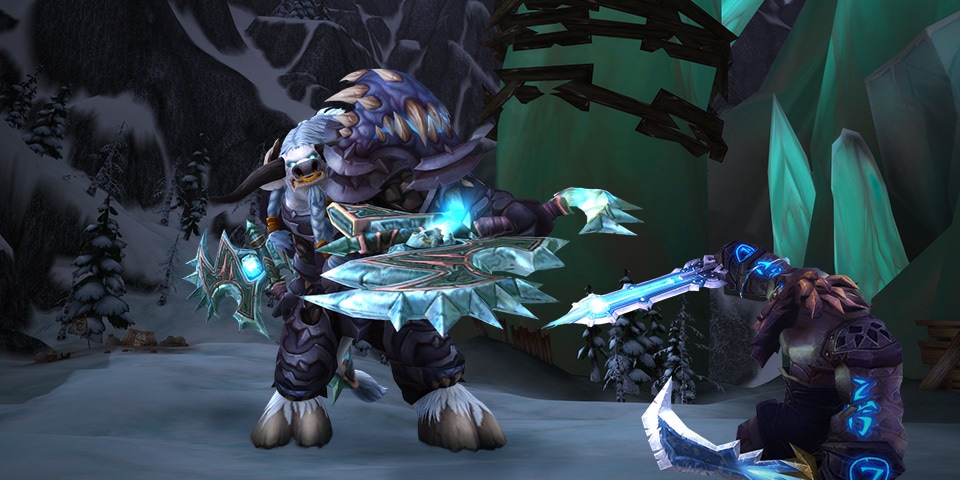

Frost
Combining martial prowess with supernatural cold, frost death knights leave their enemies chilled to the bone—and broken of the will to fight. Unlike mages who learn to harness frost magic to great effect, these death knights are born of it, rime gripping their decaying hearts. These frozen undead warriors wield dual blades to strike with ferocity and inflict deathly cold upon anyone who would stand against them.
“These death knights are born of frost magic, rime gripping their decaying hearts”
Gameplay
The mechanics of the Frost Death Knight are quite solid and we don’t want to do too much to change that. You’ll notice that the core combat abilities listed below are largely familiar. One small area where we found room for improvement, however, is in Killing Machine’s passive interaction with the core rotation. While the automatic critical strikes it provides feel good, it’s often better to ignore its proc in favor of spending resources as fast as you can, as your damage output suffers if you wait for the different resources required for using Obliterate and Frost Strike to become available. Killing Machine now only affects Obliterate, and making wise use of its effect should feel more meaningful.
Here’s a basic look at the core combat abilities for Frost Death Knights:
- Howling Blast
- 1 Rune, 30 yd range, Instant
- Blast a target with a frigid wind, dealing minor Frost damage to that target, and minor Frost damage to all other enemies within 10 yds, infecting all targets with Frost Fever
- Frost Fever
- A disease that deals minor Frost damage and has a chance to grant the Death Knight 5 Runic Power every 3 sec for 30sec.
- Obliterate
- 2 Runes, Melee Range, Instant
- A brutal attack with both weapons that deals massive Physical damage.
- Frost Strike
- 20 Runic Power, Melee Range, Instant
- Chill your weapons with icy power, and quickly strike the enemy with both weapons, dealing massive Frost damage.
- Rime
- Passive
- Your Obliterate has a 45% chance to cause your next Howling Blast to consume no Runes, generate no Runic Power, and deal 300% additional damage.
- Killing Machine
- Passive
- Your autoattacks have a chance to make your next Obliterate automatically critically strike.
- Remorseless Winter
- 1 Rune, Instant, 30 sec cooldown
- Radiate extreme cold, dealing moderate Frost damage to all enemies within 10 yards of you over 10 sec.
- Mastery: Frozen Heart
- Increases all Frost damage done by 40% (with Mastery from typical gear).
To give you an idea of how some talents may build upon this core rotation, here’s an example of a Frost-specific talent:
- Glacial Advance
- 1 Rune, Instant, 12 sec cooldown
- Summon glacial spikes from the ground that advance forward, each dealing moderate Frost damage to enemies near their eruption point.
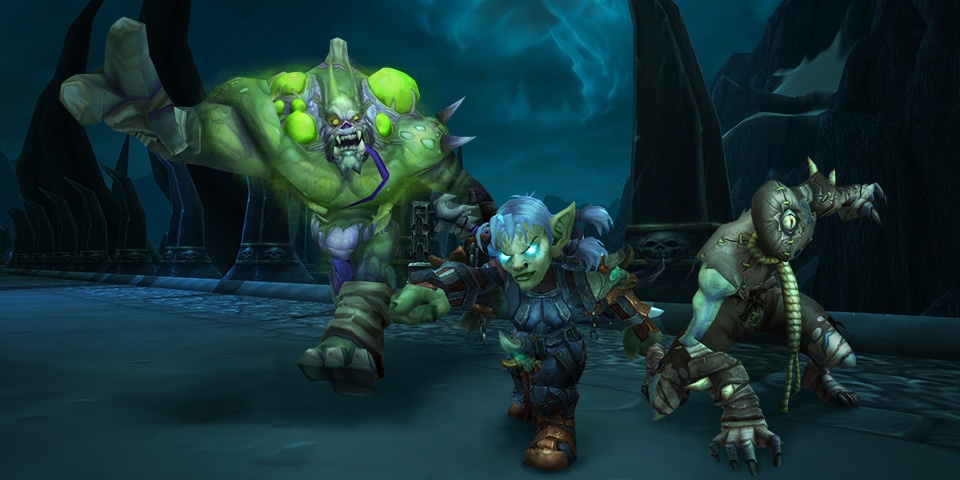

Unholy
While free from the Lich King’s grasp, some death knights still embody the ever-corrupting nature of the Scourge plague that once threatened to consume Azeroth. No matter their allegiance or cause, they remain defilers of life; and nowhere is their callousness more on display than when threatened. Inflictors of the most aggressive of diseases—and masters of raising unhallowed minions from the ground—these unholy death knights are vicious melee combatants, capable of striking with the force of an undead legion and unleashing pestilence that would bring their foes to ruin.
“Unholy death knights are vicious melee combatants, capable of unleashing pestilence that would bring their foes to ruin”
Gameplay
Unholy is receiving slightly more mechanical changes than Blood and Frost, to better realign with their unique identity. We want to ensure that Unholy continues to be the spec with the most active use of diseases. In this regard, we recognize that Festering Strike lost its luster over time and have developed a new mechanic to ensure the ability remains integral in the Unholy rotation.
Here’s a basic look at the core combat abilities for Unholy Death Knights:
- Outbreak
- 1 Rune, 30 yd range, Instant, 6 sec cooldown
- Deals minor Shadow damage and surrounds the target in a miasma lasting for 6 sec that causes the target and all nearby enemies to be infected with Virulent Plague
- Virulent Plague
- A disease that deals moderate Shadow damage every 3 sec for 21 sec. It erupts when the infected target dies, dealing moderate Shadow damage, split evenly between nearby enemies.
- The disease also has a 30% chance to erupt each time it deals damage.
- Festering Strike
- 2 Runes, Melee Range, Instant
- Deals massive Physical damage and infects the target with 1 to 3 Festering Wounds.
- Festering Wound
- A pustule-ridden lesion that may be burst by Scourge Strike, dealing moderate Shadow damage and generating 3 Runic Power.
- Scourge Strike
- 1 Rune, Melee Range, Instant
- An unholy strike that deals strong Physical damage and strong Shadow damage. Triggers a single stack of Festering Wound, if it is present on the target.
- Death Coil
- 30 Runic Power, 40 yd range, Instant
- Fires a blast of unholy energy at the target, causing strong Shadow damage to an enemy, and restoring 10 Energy to your Ghoul.
- Sudden Doom
- Passive
- Your autoattacks have a chance to make your next Death Coil cost no Runic Power.
- Dark Transformation
- Instant, 1 min cooldown
- Transform your Ghoul into a powerful undead monstrosity for 20 sec. The Ghoul’s abilities are empowered and take on new functions while the transformation is active.
- Death and Decay
- 1 Rune, 30 yd range, Instant, 30 sec cooldown
- Corrupts the ground targeted by the Death Knight, causing moderate Shadow damage over 10 sec to targets within the area. While you remain within the targeted area, your Scourge Strike will hit all nearby enemies.
- Mastery: Dreadblade
- Increases all Shadow damage done by 50% (with Mastery from typical gear).
To give you an idea of how some talents may build upon this core rotation, here’s an example of an Unholy-specific talent:
- All Will Serve
- Passive
- Your Raise Dead spell summons an additional skeletal minion, and its cooldown is removed.
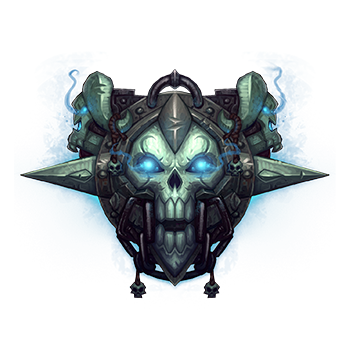

We hope you’ve enjoyed this early preview of our approach to class and specialization design in World of Warcraft: Legion. We’ll continue our review later today with a look at Shaman.
